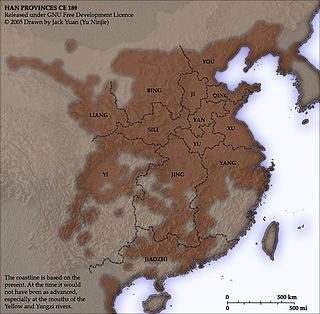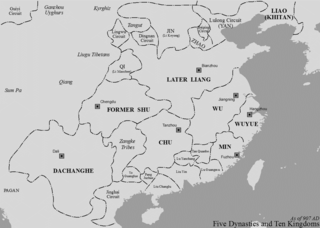Wu'an Circuit was a circuit of China during the Tang dynasty.
It was formed by the expansion and renaming of the Qinhua Circuit.
Wu'an Circuit was a circuit of China during the Tang dynasty.
It was formed by the expansion and renaming of the Qinhua Circuit.

The Tang dynasty, or Tang Empire, was an imperial dynasty of China that ruled from 618 to 907 AD, with an interregnum between 690 and 705. It was preceded by the Sui dynasty and followed by the Five Dynasties and Ten Kingdoms period. Historians generally regard the Tang as a high point in Chinese civilization, and a golden age of cosmopolitan culture. Tang territory, acquired through the military campaigns of its early rulers, rivaled that of the Han dynasty.

The Five Dynasties and Ten Kingdoms period, from 907 to 979 was an era of political upheaval and division in 10th-century Imperial China. Five states quickly succeeded one another in the Central Plain, and more than a dozen concurrent states were established elsewhere, mainly in South China. It was a prolonged period of multiple political divisions in Chinese imperial history.

A circuit was a historical political division of China and is a historical and modern administrative unit in Japan. The primary level of administrative division of Korea under the Joseon and in modern North and South Korea employs the same Chinese character as the Chinese and Japanese divisions but, because of its relatively greater importance, is usually translated as province instead.

Zhou were historical administrative and political divisions of China. Formally established during the Han dynasty, zhou existed continuously until the establishment of the Republic of China in 1912—a period of over 2000 years. Zhou were also previously used in Korea, Vietnam, and Japan.

The history of Jiangxi stretches from Lower Paleolithic times to the present, as Jiangxi was already inhabited by humans one million years ago. Until recently, the earliest known Jiangxi pottery was dated to around 11000 BC,; however, recent finds show that the absolutely earliest known pottery, from ca. 18,000 BC, comes from Xianren Cave in Jiangxi. In this Chinese province the full Neolithic period began before 8000 BC, as represented by Xianrendong culture in discovering cultivated rice over 10,000 years ago. This period is followed by the Bronze Age around 2000 BC, represented by Wucheng culture and Dayangzhou culture, and by the Iron Age prior to 500 BC.
Li Ao (772–841), courtesy name Xizhi (習之), was Chinese philosopher and prose writer of the Tang Dynasty.

Qingyuan Jiedushi (清源節度使) was a military/governance office late in China's Five Dynasties and Ten Kingdoms Period, later renamed to Pinghai Jiedushi (平海節度使). It was an office created in 949 by Southern Tang's second emperor Li Jing for the warlord Liu Congxiao, who nominally submitted to him but controlled Quan and Zhang Prefectures in de facto independence from the Southern Tang state. Starting in 960, in addition to being nominally submissive to Southern Tang, Qingyuan Circuit was also nominally submissive to Song, which had itself become Southern Tang's nominal overlord.
Huang Chao was a Chinese smuggler, soldier, and rebel, and is most well known for being the leader of a major rebellion that severely weakened the Tang dynasty.

The Shatuo, or the Shatuo Turks were a Turkic tribe that heavily influenced northern Chinese politics from the late ninth century through the tenth century. They are noted for founding three, Later Tang, Later Jin, and Later Han, of the five dynasties and one, Northern Han, of the ten kingdoms during the Five Dynasties and Ten Kingdoms period. The Northern Han would later be conquered by the Song dynasty. After which, they mostly disappeared as an ethnic group.
Jia Dan, courtesy name Dunshi (敦詩) and formally Duke Yuanjing of Wei (魏元靖公), was a Chinese cartographer, military general, and politician from Cangzhou, Hebei during the Tang Dynasty.
The following is a family tree of Chinese emperors (420–1279), from the Northern and Southern dynasties period, of the first half of the fifth century AD, until the conquest of the Southern Song dynasty in 1279 by the Yuan dynasty.
Zhou Chi, courtesy name Desheng, formally the Baron of Ru'nan, was an official of the Chinese dynasty Tang Dynasty, serving as a chancellor during the reign of Emperor Xuānzong.

Zhao was a state early in the Five Dynasties period of the history of China in what is now central Hebei. The ancestors of Zhao's only prince, Wang Rong, had long governed the region as military governors (Jiedushi) of the Tang dynasty's Chengde Circuit, and after the collapse of the Tang in 907, the succeeding Later Liang's founding emperor ("Taizu"), Zhu Wen made Wang, then his vassal, the Prince of Zhao. In 910, when the Emperor tried to directly take over the territory of Zhao and its neighboring Yiwu Circuit, Wang Rong and Yiwu's military governor Wang Chuzhi turned against the Later Liang, aligning themselves with Later Liang's archenemy, Jin's prince, Li Cunxu, instead. In 921, Wang Rong's soldiers assassinated him, slaughtered the Wang clan, and supported his adoptive son Zhang Wenli to succeed him instead. Li Cunxu soon defeated Zhang Wenli's son and successor Zhang Chujin and incorporated Zhao into Jin territory.

Jiangnan Circuit or Jiangnan Province was one of the major circuits during the Tang dynasty, Five Dynasties period, and early Song dynasty. During the Tang dynasty it was known as Jiangnan Dao (江南道), and during the Song dynasty Jiangnan Lu (江南路), but both dao and lu can be translated as "circuit". In 1020 it was divided into 2 circuits: Jiangnan East Circuit and Jiangnan West Circuit.

Jin, also known as Hedong (河東) and Former Jin (前晉) in Chinese historiography, was an early state of the imperial Chinese Five Dynasties and Ten Kingdoms period until 923 when it became the Later Tang dynasty (923–937). Its princely rulers were the Shatuo warlords Li Keyong and Li Cunxu. Although the Five Dynasties period began only in 907, Li Keyong's territory which centered around modern Shanxi can be referred to as Jin as early as 896, when he was officially created the Prince of Jin by the failing and powerless Tang dynasty court, or even as early as 883, when he was created the jiedushi military governor of Hedong Circuit, which controlled more or less the same territory.

Kui Prefecture, Kuizhou Circuit, or Kuizhou was initially established in 619 CE, as a renaming of the existing Xin Prefecture. Kuizhou was an important area from the beginning and through the end of the Tang Dynasty of China, when it was alternatively part of several of the Circuits which made up typical large scale political structural organizations of the Tang era. Kuizhou continued as a political entity through the end of the Song Dynasty, during which it was of Provincial level, a typical large scale political organization of Song era. Kui Prefecture was located in what is now eastern Chongqing. During the Song Dynasty, Kuizhou's capital was located in what is now Fengjie County, Chongqing, and the extent of the province was to what today includes Chongqing, eastern Sichuan, and Guizhou. Part of the importance of Kuizhou was related to its prominent location along the Yangzi River. Kui was also known for its spectacular scenerary, and being a location in which exiled poets wrote their laments.

The Tang dynasty of China administered territory using a hierarchical system of three descending divisions: circuits, prefectures, and counties. Prefectures have been called jùn (郡) as well as zhōu (州) interchangeably throughout history, leading to cases of confusion, but in reality their political status was the same. The prefectures were furthered classified as either Upper Prefectures, Middle Prefectures, or Lower Prefectures depending on population. An Upper Prefecture consisted of 40, 000 households and above, a Middle Prefecture 20, 000 households and above, and a Lower Prefecture anything below 20, 000 households. Some prefectures were further categorized as bulwark prefectures, grand prefectures, renowned prefectures, or key prefectures for strategic purposes. A superior prefecture was called a fu (府).
Jingzhao was a historical region centered on the ancient Chinese capital of Chang'an.
Hebei Circuit or Hebei Province was one of the major circuits during the Tang dynasty, Five Dynasties period, and early Song dynasty. During the Tang dynasty it was known as Hebei Dao (河北道), and during the Song dynasty Hebei Lu (河北路), but both dao and lu can be translated as "circuit". In 1042 it was divided into two circuits: Hebei East Circuit and Hebei West Circuit.

Liangzhe Circuit (997–1160s) was one of the major circuits during the Song dynasty (960–1279). Its administrative area corresponds roughly to modern Zhejiang, Shanghai, and southern Jiangsu. The fertile Yangtze River Delta lay within Liangzhe Circuit, as did Lake Tai. Liangzhe was the wealthiest circuit in Song.